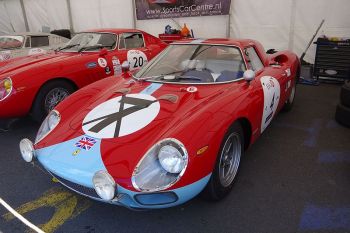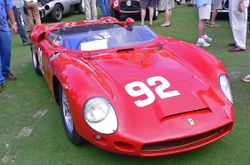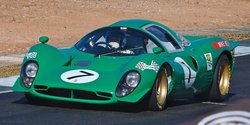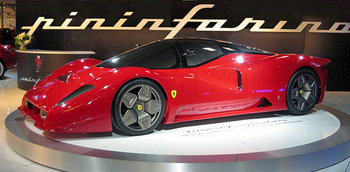Ferrari P
The Ferrari P series were prototype sports cars in the 1960s and early 1970s.
Although Enzo Ferrari resisted the move even with Cooper dominating F1, Ferrari began producing mid-engined racing cars in 1960 with the Ferrari Dino-V6-engine Formula 2 156, which would be turned into the Formula 1-winner of 1961.
Sports car racers followed in 1963. Although these cars shared their names (based on engine displacement) with road models, they were almost entirely dissimilar. The first Ferrari mid-engine in a road car did not arrive until the 1967 Dino, and it was 1971 before a Ferrari V12 was placed behind a road-going driver in the 365 GT4 BB.
250 P
| 1963 Ferrari 250P |
|---|
The 250 P was a Prototype racer produced in 1963, winning the 12 Hours of Sebring, 24 Hours of Le Mans, and the manufacturers' championship. It was a mid-engined sports car racer with a 250 Testa Rossa V12 engine and almost entirely unrelated to the other 250 cars.
250 LM
| Ferrari 250 LM |
|---|
The 250 P evolved into a saleable mid-engined racer for the public, the 250 Le Mans. Introduced at Paris in November, 1963, the LM was successful for privately-entered racers around the world. Notably, a 250 LM entered by the North American Racing Team won the 1965 24 Hours of Le Mans driven by Jochen Rindt and Masten Gregory, which remains as Ferrari's last overall victory in the endurance classic. About 32 models were built in 1964 and 1965, with all but the first few powered by 3.3 L 320 hp (238 kW) engines, though the name did not change with the increase in displacement. A fully-independent double wishbone suspension was specified with rack and pinion steering and four wheel disc brakes. Ferrari had intended that the 250 LM be homological for racing as a Group 3 Grand Touring Car, however in April 1964 the FIA refused to do so as Ferrari had built considerably fewer than the required 100 units. The 250 LM thus had to run as a Prototype until it was homological as a Group 4 Sports Car for the 1966 season.
330 P
| Ferrari 330 P |
|---|
The 250 P was stretched in 1964 to accept the 4.0 L 330 engine, becoming the 330 P.
330 P2
An entirely new car, the 330 P2, followed in 1965. It was first used by Luigi Chinetti's North American Racing Team (NART) in the Daytona race that year. It was powered by a 410 hp (305 kW) version of the 330 V12.
330 P3
| Ferrari 330 P3/P4 |
|---|
The 1966 330 P3 introduced fuel injection to the Ferrari stable. It also used a P3 (Type 593) transmission that was prone to failure and was replaced by a ZF Friedrichshafen AG transmission when the P3 were converted to 412P's, another Ferrari first that would only last one season when the ZF's were replaced by 603R P4 transmissions in the 412P's.
330 P4
1967 was a banner year for the Enzo Ferrari motor company, as it saw the production of the mid-engined 330 P4,[1] a V12-engined endurance car intended to replace the previous year's 330 P3. Only four Ferrari P4-engined cars were ever made: three new 330 P4s and one ex P3 chassis (0846). Their three-valve cylinder head was modeled after those of Italian Grand Prix-winning Formula One cars. To this was added the same fuel injection system from the P3 for an output of up to 450 hp (335 kW).
The P3 won the 1000 km Monza in 1966, and the P4 won the same race in 1967. Two P4s, and one 412 P crossed the finish line together (in first 0846, second 0856, and third place 0844) in the 1967 24 Hours of Daytona, for a photo finish to counter Ford's photo of the Ford GT40 Mk.II crossing the finish line together First, Second, and Third at the 1966 24 Hours of Le Mans.
Since then, the fate of these four cars has been the subject of much attention.
- 0846. Built in 1966 as the first of 3 works 330 P3s and the only P3 Spyder. Retained by the works at the end of 1966 and used as the basis for the new P4 and partially converted to P4 specification for 1967. Ferrari states 0846 no longer exists. It was decided by the factory to scrap the chassis due to its previous accident history and fire damage sustained at Le Mans, 1967. The original chassis number has been written off Ferrari's books as an existing chassis, but the number is still in their ownership. Template:Fact
- 0856 was originally built as a Berlinetta but converted by the factory into a Spyder for Brands Hatch, 1967 as it remains today. Currently owned by Lawrence Stroll.
- 0858 was originally a Berlinetta but converted by Ferrari into a Spyder for Brands Hatch, 1967 and later in the year converted into a 350 Can-Am by them. Now fitted with a P4 Berlinetta body and is in German ownership.
- 0860 was also originally a Berlinetta and converted to a Spyder for Brands Hatch, 1967 and like 0858 converted by Ferrari to a 350 Can-Am but was fitted with a P4 Spyder body in the early 1970s by its then French owner in whose family it remains today.
412 P
| Ferrari 412 P |
|---|
The Ferrari 412P was a "consumer version" of the famous 330 P3 race car, built for independent teams like NART (0844), Scuderia Filipinetti (0848), Francorchamps (0850), and Maranello Concessionaires (0854). These cars had carburetor engines instead of the factory Lucas fuel injection. Surviving 412P cars are worth approximately 6 million nowadays.
There are only 2 cars that were originally built as 412P's: 0850 and 0854. P3 chassis. P3 Typo Motors except for Carburetors in place of FI. P4 Suspension but P3 wheelbase 2412mm vs. 2400mm (P4 and P 3/4 0846) 0844 and 0848 were originally P3 Factory Racecars but when Ferrari sold them to customers they removed the Lucas Mechanical Fuel Injection and replaced it with Weber carburetors which reduced their output, something Ferrari wanted to do so that they would win points but not beat the factory cars which were then P 3/4 0846 (See Above), P4 0856, P4 0858, and P4 0860.
The P3's and 412P had the same 4 liter block which is different from the P4 4 liter block and all had P3 not P4 chassis. P 3/4 0846 is unique having, after modification by Ferrari for the 1967 race season, a P3 chassis with a P4 engine.
The 412Ps, the 330 P 3/4, and the 330 P4's, all had 4 liter engines that weren't eligible for the biggest races (such as Le Mans) after 1967; not enough 412P's, 330 P 3/4, or P4's were built to be allowed under 5000cc sport cars class (which required 25 identical cars to have been built). The smaller number of 412Ps, 330 P 3/4, and P4's meant that they were still classed as "Prototypes". Engine size in that class was limited to 3 liters after 1967, the fastest Ferraris were no longer eligible and Enzo left sports car racing for a while in protest.
Four 412 Ps were built:
- 0844 was a converted P3 and is currently in the UK
- 0848 was a converted P3 and is currently in Switzerland
- 0850 is currently owned by an American
- 0854 is currently owned by James Glickenhaus, who also commissioned and owns the Ferrari P4/5
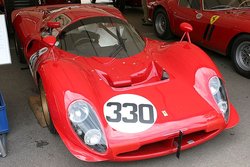
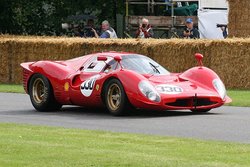
330 P 3/4 and P4
1967 saw the ultimate mid-engined 330 P, the 330 P4. With a 3-valve cylinder head (taken from the Italian Grand Prix-winning Formula 1 cars) added to the P3's fuel injection system, output was up to 450 hp (335 kW). Only one P 3/4 and three 330 P4's were ever made.
The 330 P4 electrified the racing world when one P 3/4, one P4 and one 412P crossed the finish line together (in first, second, and third place) in the 1967 24 Hours of Daytona and became a symbol of victory over arch-enemy Ford GT40. Surprisingly the 330 P4 had poor aerodynamics even in comparison with its rivals, but its sexy looks continue to grab attention.
The original P4 cars are estimated to be worth about US$10 million each.
All of the P4's built are accounted for and P 3/4 0846 is surrounded in controversy. 0856 remains in its original state and is owned by a Canadian collector, 0858 was converted into a 350 Can Am and is owned by American Walter Medlin, and 0860 was also converted to a 350 Can Am but is presently wearing a P4 Spyder body and is in a French automobile museum. The fourth of the original cars, chassis number 0846, was originally built as a P3 by Ferrari but was modified in December 1966 to accept a P4 engine while retaining its P3 chassis and nose. This P3/4 was subsequently badly damaged in an accident at Le Mans and was discarded by Ferrari.
Recently, many components of P3/4 0846 appear to have resurfaced in the possession of exotic car collector and enthusiast James Glickenhaus, a former movie director and stock exchange magnate. Although both he and David Piper (from whom he acquired the car) thought it was one of four replica chassis constructed with the blessing of Enzo Ferrari in the late 1960s, it appears that nearly all of the tube frame chassis and some other components from the wrecked P3/4 were used in this car. This seeming discovery has stirred much controversy among Ferrari enthusiasts, and the Ferrari company is unable or unwilling to officially identify the car except to note that their records hold that it was "scrapped" "written off". This tube frame appears to be a P3 modified to hold a P4 engine, as was the case with 0846 exclusively, and the damage from two contemporary racing accidents appears in the frame as well. The car's transmission, engine heads, and steering rack also include the correct Le Mans scrutineering marks, linking them to P3 0846 and P 3/4 0846 of 1966 and 1967.
link title0846 and P 4/5 Video]
One original 330 P 3/4 and three original 330 P4s were built in total:
- 0846 was a converted P3 (see above)
- 0856 remains in its original state and is owned by a Canadian collector
- 0858 was converted into a 350 Can Am and is owned by American Walter Medlin
- 0860 was also converted to a 350 Can am and is in a French automobile museum
- 0900 was a continuation commissioned and currently owned by David Piper and authorized by Enzo Ferrari
- 0900a is another currently unfinished continuation by Piper
- "0003" is claimed to be a third continuation by Piper but has been determined by owner James Glickenhaus to be 0846
- 0900b is a fourth continuation still under construction the frame of which was made in the 2000s by Piper for an American customer.
Due to its great fame and good looks, more than a hundred P4 replicas of various design have been built. A high-quality P4 replica built with genuine Ferrari engine (e.g. a 400i V12) may command as much as $200,000, but simpler ones (often with Rover engines and Renault drive-trains) may be sold for $50,000.
312 P
Main article: Ferrari 312P
After boycotting sports cars racing in 1968 to protest the rule change, Ferrari built another 3000cc prototype in 1969, named the 312 P.
The 3.0 Ferrari 312P Barchetta and 3.0 Ferrari 312P Berlinetta were hardly more than a 3-litre F1 Ferrari 312 with a prototype body. At the 12 Hours of Sebring the spyder finished 2nd to a JWA Gulf Ford GT40. At the BOAC 500 in Brands Hatch the same spyder was 4th behind three Porsche 908-01. At 1000km Monza, Chris Amon took the pole with the 312P spyder, ahead of Jo Siffert's 908-01, but had to retire. At the 1000km Spa, a 312P was second behind the Siffert-Redman 908-01LH. At Le Mans two 312P Berlinettas were entered. They were 5 and 6 on the grid, but didn't finish. At the end of the season the 312Ps were sold to N.A.R.T., the American Ferrari importer of Luigi Chinetti.
512 S and 512 M
Main article: Ferrari 512
These were not designated with P as they were not built for the 3000cc Prototype category, but with S as 5000cc Sports cars, of which at least 25 had to be built. Porsche had made that investment in early 1969 with the new Porsche 917. Ferrari answered with the Ferrari 512 which was introduced for 1970, and later modified as 512 M.
312 PB
Main article: Ferrari 312PB
In 1971, another rule change was announced for 1972, and Ferrari abandoned further development of the 512 in order to focus on a new 3L prototype based on the F1 car.
In 1972, this Ferrari 312PB with the flat boxer engine was very successful and won all races of the World Sportscar Championship in which it raced. Ferrari didn't enter the 24 Hours of Le Mans in 1972 though as the F1-based engine would not last for sure.
They had to enter in 1973, though, and finished second behind Matra, same as in the championship. At the end of the 1973 season, Ferrari abandoned sports car racing to focus on F1.
External Video Links
333 SP
Main article: Ferrari 333 SP
In the 1990s, the Ferrari 333 SP was built, but not raced by the factory itself.
P4/5
Main article: Ferrari P4/5
In 2005, James Glickenhaus commissioned Pininfarina to rebody an Enzo as a special one-off custom car. It is inspired by the early P racers, and especially Glickenhaus' own reconstructed P3/4. P4/5 Video
| < Ferrari timeline 1948–1967 | Ferrari timeline 1960s-1990s | Ferrari timeline 1990–Present > | |||||||||||||||||||||||||||||||||||||||
| Type | 1960s | 1970s | 1980s | 1990s | |||||||||||||||||||||||||||||||||||||
| 0 | 1 | 2 | 3 | 4 | 5 | 6 | 7 | 8 | 9 | 0 | 1 | 2 | 3 | 4 | 5 | 6 | 7 | 8 | 9 | 0 | 1 | 2 | 3 | 4 | 5 | 6 | 7 | 8 | 9 | 0 | 1 | 2 | 3 | 4 | 5 | 6 | 7 | 8 | 9 | ||
| 8 cylinder | Mid-engine berlinetta | 308 | 308 i | 308 QV | 328 | 348 | 360 | ||||||||||||||||||||||||||||||||||
| 208 | 208 Turbo | GTB/GTS Turbo | F355 | ||||||||||||||||||||||||||||||||||||||
| Mid-engine 2+2 | 308 GT4 | Mondial 8 | Mondial QV | Mondial 3.2 | Mondial t | ||||||||||||||||||||||||||||||||||||
| 208 GT4 | |||||||||||||||||||||||||||||||||||||||||
| 12 cylinder | Boxer berlinetta | 365 BB | 512 BB | 512i BB | Testarossa | 512TR | F512M | ||||||||||||||||||||||||||||||||||
| Grand tourer | 250 | 275 | 365 GTB/4 "Daytona" |
550 Maranello | |||||||||||||||||||||||||||||||||||||
| America | 330 | 365 | |||||||||||||||||||||||||||||||||||||||
| 2+2 coupé | 250 GT/E | 330 GT 2+2 | 365 GT 2+2 | 365GTC/4 | GT4 2+2 | 400 | 400 i | 412 | 456 | 456 M | |||||||||||||||||||||||||||||||
| Supercar | 250 GTO | 250 LM | 288 GTO |
F40 | F50 | ||||||||||||||||||||||||||||||||||||
| Sold under the Dino marque until 1976; see also Ferrari Dino | |||||||||||||||||||||||||||||||||||||||||
